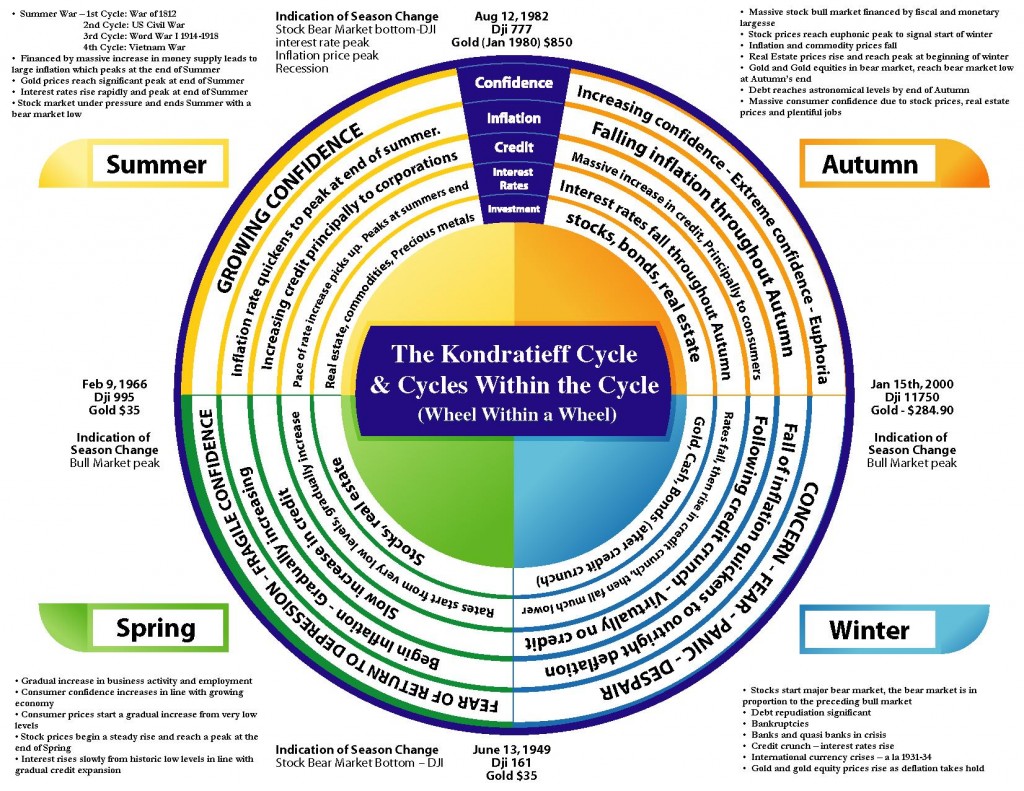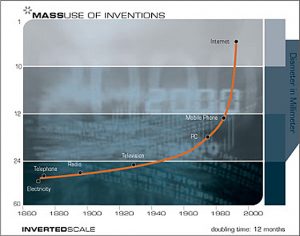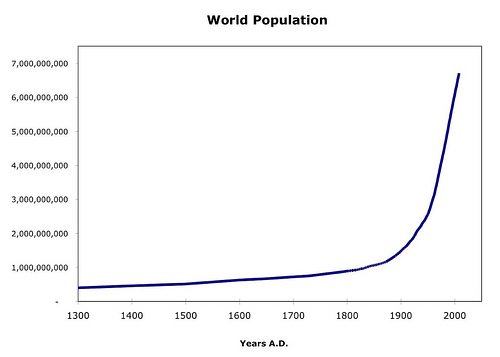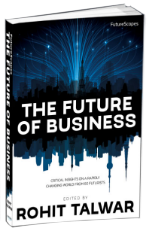Patterns of Change | After the Millennials – Generation XYZ Consulting
Nobody can predict the future. Yet we predict every day to make sense of the world around us and determine our actions. Like captains on the ocean, we navigate our ways to try to find the smoothest sailings and the best shores. But in navigating through time we have no global positioning system to guide us, just past experiences and good foresight.
“Everything in the world may be endured except continued prosperity” ~ Goethe
When studying change over time we tend to see different patterns depending on which system we study. Most patterns in nature are cyclical or self regulating feedback loops. Predator-prey dynamics tend to follow an oscillating pattern. Pray overstock fosters a larger predator population, which in turn decreases when the higher level of predation overshoots the prey population’s capacity to maintain reproduction, which in turn starves the predators. Think of the water cycle or seasons and daytime/nighttime cycles, which are caused by the the earths regular movement.
In Eastern religions a cyclical worldview has given life to ideas about reincarnation, which in its most banal interpretation could be thought of as the soul’s cyclical pattern of entering and leaving physical bodies.
Modern Western societies have operated with more linear paradigms, but also here we see an increasing acceptance of the cyclical behavior of various aspects of society. Economic conditions tend to accelerate and decelerate in a cyclical manner, as do other social phenomena. The interplay between economic and social phenomena often shows itself as boom and bust models where fluctuating psychological moods exaggerate the economic swings and turn markets either bullish or bearish. Long waves, such as those that were discovered by the Russian economist Nicolai Kondratiev, tend to be connected to innovation cycles and techno-economic paradigms. New production models and economic transaction patterns emerge and drive change in the labor market and other realms of society too.
Cycle theories such as that of Kondratiev inspired generational experts William Strauss and Neil Howe, the authors behind Generations, The Fourth Turning and The Millennials Rising. Like Kondratiev, Strauss and Howe compare this cyclical behavior to seasonal variations. Each season lasts for about a generation and their properties make up the environmental factors that influence social moods, which in turn influence the ‘personality traits’ that often characterize a generation. The Millennials for instance – many of whom served to fight in the War on Terror – has it’s parallel in the G.I. generation who fought in World War II*. Both came of age during times tested by military tensions and economic recessions, and both generations show the typical characteristics of team players and institution builders. The New Silents – the young protagonists of this blog – are parallelled by the “original” Silents who were born during the 1930s and early 1940s. Just like children today, they were born into an era of military and economic distress to overprotective parents. Please check out Generations Timeline for more information.
Psychologist Abraham Maslow suggested that a person’s values to a great extent can be explained by the nature of their needs given by their position in society. A person who has felt hunger first-hand will have different motivations and values than a person who grows up in physical affluence. When great chunks of society go through these phases simultaneously, society level changes may follow. Cyclical theories share many ideas with Maslow’s theory, but suggest the element of social decline, which renders a cyclical or wavy instead of hierarchical appearance.
“Lo! Men have become the tools of their tools” ~Henry David Thoreau
But if social change is characterized by fluctuations, changes within computer technology seem to follow a trajectory of exponential growth with no plateaus or deceleration in sight. Moore’s law, developed in the computer’s stone age of 1970, suggested that the number of transistors that can fit on an integrated circuit doubles every other year. Ray Kurzweil has expanded this principle and introduced the Law of Accelerating Returns. According to Kurzweil computer intelligence adapts a zillion times faster than human evolution and is determined to surpass us sometime during the next three decades. This is what is called the Singularity.
World population growth is the other exponential graph that is greatly impacting our planet and its bounties. Accelerating technological development can on the one hand be our lifeboat as it leads to things like more drought resistant crops, alternative forms of energy and more fuel efficient vehicles. On the other it allows us to live longer – maybe even forever, which needless to say, will make it even more crowded here! But even world population growth is highly likely to level off sometime around 2050.
At the macro scale, or in the historic long view, we often see cyclical or exponential patterns – which in turn plateau and render an S-shaped appearance. But this is simply a historically observed pattern and not necessarily indicating causation. The very idea of patterns seems to suggest that social change is driven by incremental changes on predetermined paths, but this idea would be misleading. Disruptive changes in technology, environment or politics have a tendency to abruptly sever existing trajectories and stake out totally new futures.
Sometimes these changes come in the form of reaching the tipping point of an ecosystem’s carrying capacity (think about the rapid decline of civilization on the Easter Islands), which abruptly changes the current course. Sometimes extreme and sudden events come by in the form of revolution or terrorist attacks that severs past from present. While the onset of such events often come as a surprise, the sentiments that leed up to them are usually pretty clear. Sometimes these types of events were even forecasted, yet ignored. One example is the terrorist attacks of 9/11, which has gone down in history as a “surprise” despite the many warnings from individual terrorist experts and commissions before hand.
Sometimes a scientific discovery or invention of a new technology becomes so crucial that older systems are thrown out or withering away. These technologies or breakthroughs can be so immersive and transformational that subsequent generations cannot even imagine life without them. We can think of the advent of heliocentrism or sweeping technological changes such as the automobile or the internet.
 Many futurists believe that extreme events of these types are becoming more and more frequent. Globalization, disruptive technological changes, climate change are all factors that foster extreme events. So extreme, in fact that we are about to break some of the “natural cycles” our civilization depends on.
Many futurists believe that extreme events of these types are becoming more and more frequent. Globalization, disruptive technological changes, climate change are all factors that foster extreme events. So extreme, in fact that we are about to break some of the “natural cycles” our civilization depends on.
Increasing interconnectedness in various systems can send a worldwide web of dominos on a collision course. The recent financial crises which is currently spurring civil protests across the world exemplifies the dramatic consequences of a “hyperconnected” global financial system.
These dynamics are some of the reasons for why simple forecasting aimed at depicting one particular future is becoming increasingly difficult. Instead many future practitioners and strategic foresight professionals help their clients spell out logically coherent alternative futures in the form of scenarios. In a time ridden with extreme wildcards, subsurface digging and close monitoring of undercurrents is essential in order to anticipate future “social earthquakes”.
As a futurist I strive to be a societal geigerteller or at least step up on the shoulders of the giants who are. I may not always hear the rumbling. Or I may misinterpret the rumbling I hear. The epicenter may be miles – or rather decades – away from where (or when) I anticipated it. I may not always be right. But my job is not to be right all the time, but to have thought the “unthinkable” thoughts and seen the previously “unthinkable” signs that makes us better prepared when the earthquake does happen. Because it will. No, they will. Soon.
Anne Boysen
Notes:
* The vast deployment of Boomers to the Vietnam War cannot be overlooked. However, the societal sentiment at the time went against the values symbolized by war and military pride, which may have weakened this generation’s inclination to identify itself with these values.




